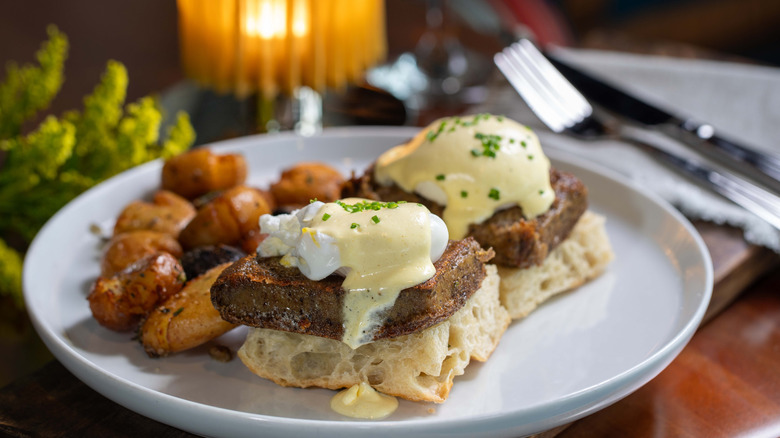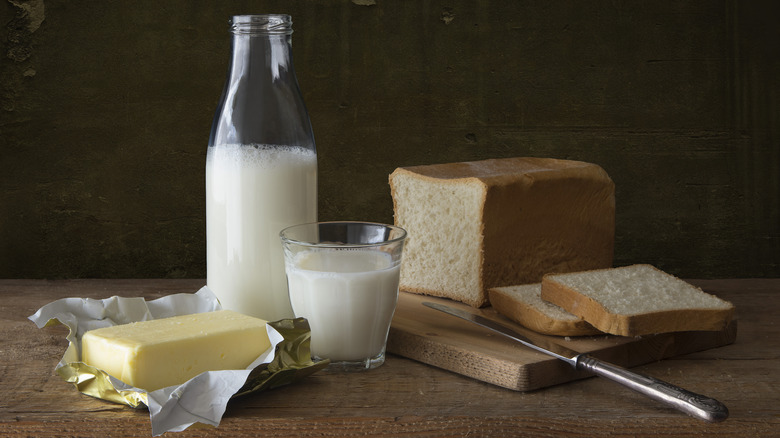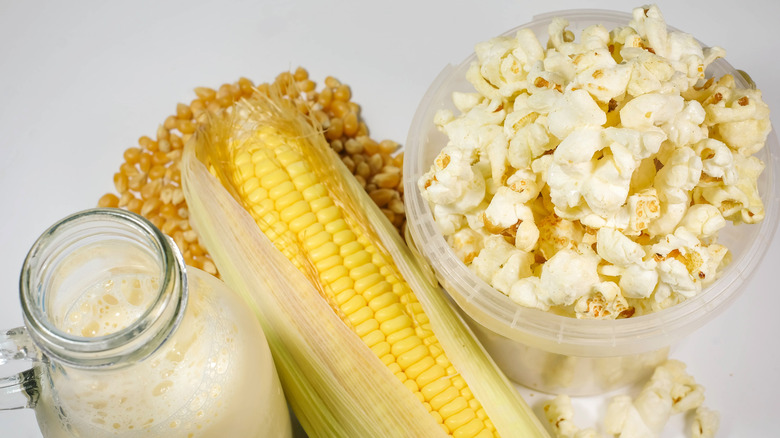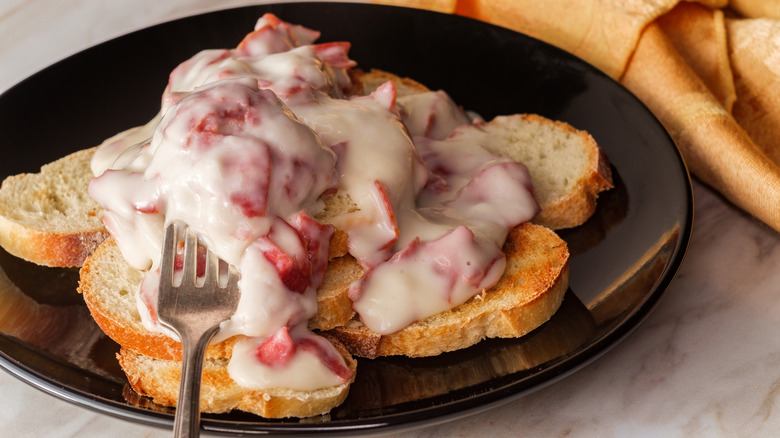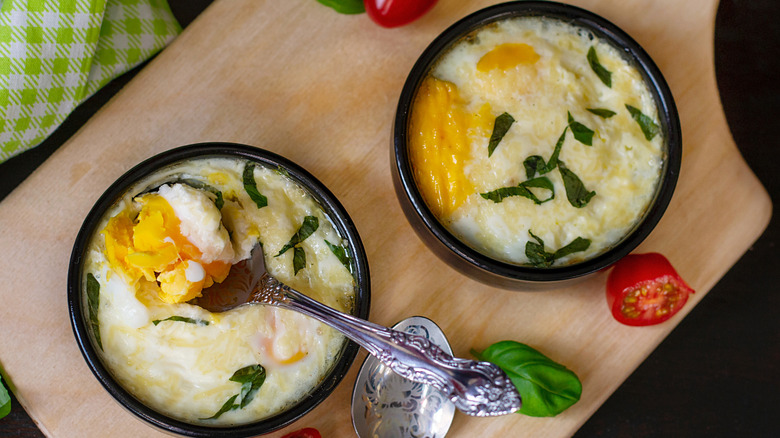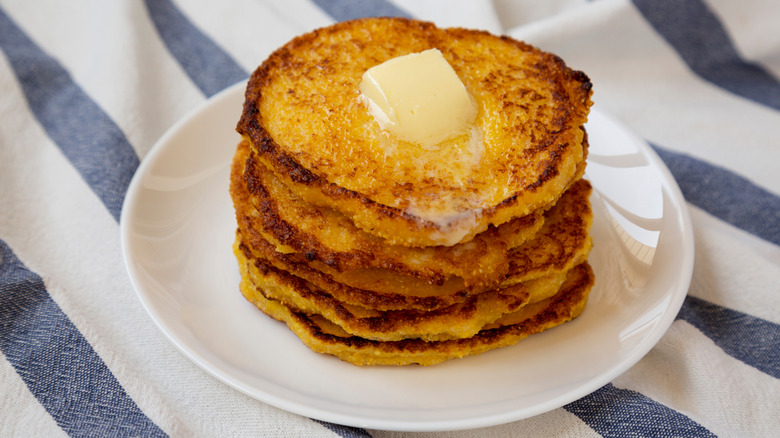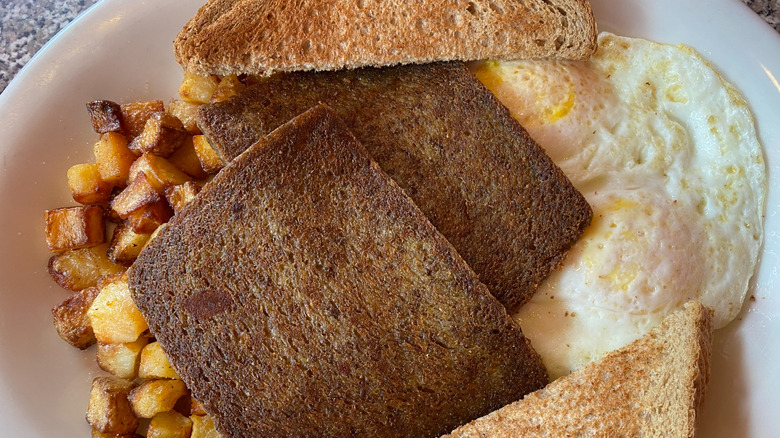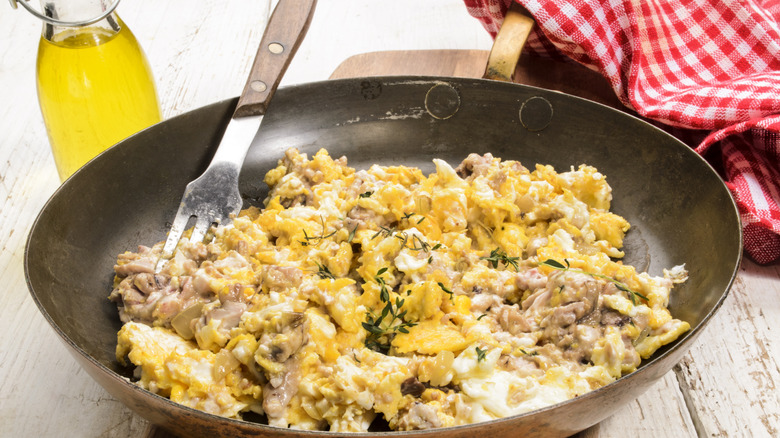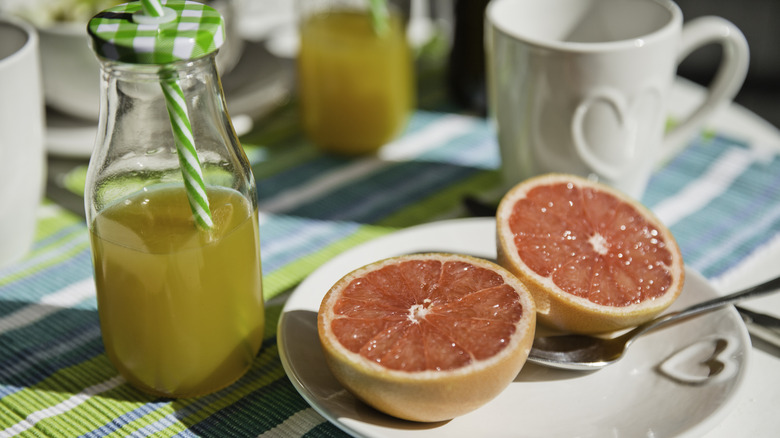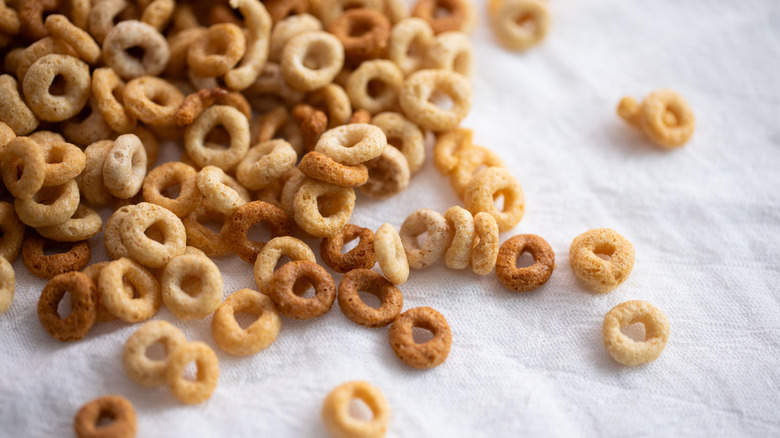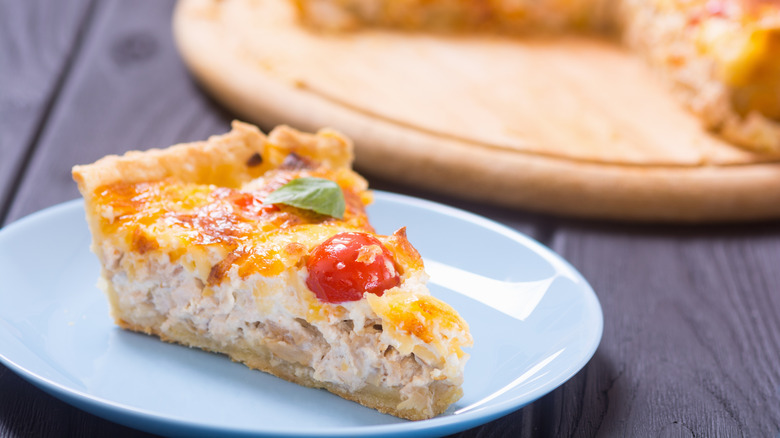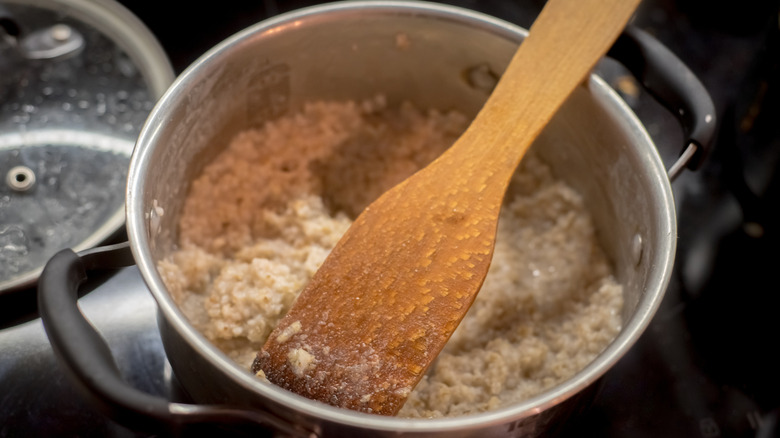Old-School Breakfasts You Don't See People Eating Today
Remember when breakfast didn't come in a box, cup, or bar? Back before almond milk lattes and $12 avocado toast took over the morning scene, people sat down to meals that were hearty, homemade, and — let's be honest — sometimes a little odd by today's standards. Think mushy toast soaked in warm milk, sizzling pork scraps in cornmeal, or popcorn swimming in cream. These were the breakfasts that fueled generations before us. Some were born out of thrift, others from convenience, and a few from good ol' fashioned culinary curiosity.
But for one reason or another — changing tastes, faster lifestyles, the invention of Pop-Tarts — these old-school breakfasts have quietly slipped off the menu. In this article, we're flipping back through the recipe box to revisit the breakfast dishes your great-great-grandma loved and your great-uncle maybe still makes. Just don't be surprised if you end up craving a grapefruit half or buttered O's by the end.
Milk toast
Long before Golden Grahams or French Toast Crunch turned breakfast into a sugar-fueled cartoon, kids devoured bowlfuls of milk toast — bits of toast tossed into boiled sweet milk and served up with a little sugar and nutmeg. But milk toast wasn't a one-recipe wonder. Many recipes kept the toast intact instead of breaking it into pieces. Some added flour to thicken the milk. Others took a savory approach by adding meat or veggies.
Milk toast was more than just "a fine dish for breakfast on a cold day," as the 1920 "The Cook Book of Left-Overs" called it. It was basically the Vicks VapoRub of the food world. Back in the 1800s and early 1900s, doctors recommended milk toast as a "feel better soon" meal for almost any ailment. Suffering from diarrhea? Gout? Mumps? Here, have some milk toast.
But the Wheat Council of the United States and makers of electric toasters wanted to make sure that milk toast was known as much more than just sick-day mush. In 1924, Exeter and Hampton Electric Company teamed up with the Wheat Council to launch the "Eat More Toast" campaign. They distributed a leaflet called "Toast — Good Ways to Use an Old Friend." One of the featured recipes — milk toast. Their version called for hot salted milk poured over slices of buttered toast and sprinkled with paprika. They touted this warm plate of soggy toast and milk as "one of the best things to give a school child for breakfast."
Popcorn cereal
Americans consume billions of dollars worth of cereal every year. But long before the breakfast aisle offered an overwhelming number of cereal choices, Americans were pouring milk over something a little ... poppier.
Yes, popcorn. Not the movie snack. Not the stadium or fairground treat. In the 1800s and early 1900s, popcorn was a popular breakfast cereal. It was cheap and endlessly adaptable. Sometimes, it was just popcorn, cold milk, and a bit of sugar. But it could also be served hot. Or with mix-ins like stewed apples, plump raisins, or a splash of fruit juice. In "Science in the Kitchen," Mrs. E.E. Kellogg described ground popcorn as "a delectable dish eaten with milk or cream." That name might ring a bell — Ella Eaton Kellogg was the wife of Dr. John Kellogg. It was in Ella's experimental kitchen where they accidentally flaked wheat into a crisp cereal. That happy accident was later replicated with corn. The rights were sold to John's brother William, who turned them into the now-iconic Kellogg's Corn Flakes.
While Kellogg's and other cereals thrived, popcorn cereal quietly faded into history. It turns out it had one fatal flaw — sogginess. Some people just couldn't stomach how quickly it turned mushy. And once boxed cereal came along, with its convenience, crunch, and colorful mascots, popping corn in the morning suddenly felt like way too much work. Still, next time you're snacking on popcorn, just remember — you're only a splash of milk away from enjoying breakfast, 19th-century style.
Creamed chipped beef on toast
Creamed chipped beef on toast first reported for duty in the U.S. Army back in 1910, when it appeared in the "Manual for Army Cooks." The mission? Feed a lot of hungry troops with something hearty, comforting, and pantry-friendly. The original recipe — thin slices of dried beef simmered in a creamy, peppery sauce, poured over toast — required 15 pounds of chipped beef and served 60 hungry heroes.
Gaining the less-than-glamorous nickname "S.O.S." (short for "s*** on a shingle"), the dish was a beloved breakfast staple, even if the name suggests otherwise. But let's be honest, even the tastiest meals can wear out their welcome, and S.O.S. gained a couple of other meanings too: "Save Our Stomachs" and "Same Ol' Stuff." In some places, the dish was served almost daily.
Not content to be confined to military life, creamed chipped beef steadily marched its way into the heart of American breakfast culture. It found new recruits at Civilian Conservation Corps canteens, Boy Scout camps, and graced the pages of Good Housekeeping and Woman's Home Companion. It even earned a spot on the menu at places like IHOP and Cracker Barrel. It's since gone MIA from many restaurants and kitchen tables, though the military still serves a variation of it. It's now called Creamed Ground Beef, as chipped beef has been honorably discharged. If you're feeling nostalgic and want to try the dish at home, an easy creamed chipped beef on toast recipe stands at attention.
Shirred eggs
Shirred eggs may sound fancy, but they're really just baked eggs. Traditionally cooked in a flat-bottomed dish (called, appropriately, an egg shirrer), shirred eggs are baked and served right in the same dish. These eggs were popular in the 1800s and made a glamorous comeback in the 1950s and 1960s, when newspapers sang their praises as the perfect meal for impressing company.
The basic version is simple: Butter your dish, crack in a few eggs, drizzle hot melted butter over the yolks, and bake in a slow oven for a few minutes. Of course, even back in the day, no one could resist tinkering with a good thing. In 1898, Adolphe Meyer's "Eggs and How to Use Them" listed over 50 ideas for dressing up shirred eggs — mushrooms, chestnuts cooked in broth, chicken livers, eggplant — basically, anything goes.
Some recipes layered tasty bits, such as slices of ham, directly on the dish and poured the egg over them. Others piled ingredients on top. Most ingredients work either way — cook the eggs in a bath of thick cream, or pour the cream over the egg. Or both might be the best option — like strips of bacon on the bottom and bits sprinkled on top. And don't forget the sides of the dish —some recipes call for lining the entire buttered dish with fine cracker crumbs and sprinkling buttered crumbs on top. With endless possibilities, shirred eggs are the kind of classic that really shouldn't be over easy — or over.
Hoecakes and Johnny cakes
Hoecakes and Johnny cakes might sound like they're part of a vintage dance playlist your grandparents enjoyed. In reality, they're cornmeal flatbreads wrapped in culinary confusion. Some say the name "hoecake" comes from early versions that were cooked on the blade of a hoe. Others think "hoecake" was a mispronunciation of a Native American word for ground corn cakes. Still, others believe hoecakes were made on a cooking tool called a "hoe." In some places, the terms "hoe" and "griddle" are interchangeable. And in parts of the South, pancakes are sometimes called hoecakes.
Generally, though, a pancake is fluffier while a hoecake is flat and dense, with crisp edges. Unlike pancakes, hoecakes don't rise to the occasion with baking powder or baking soda — just cornmeal, water, and salt. They might be topped with butter and honey — indeed, those were George Washington's preferred toppings. Hoecakes with tea were one of his favorite breakfasts.
But wait — was Washington really eating hoecakes? Depends on who you ask. In some circles, "hoecake" and "Johnny cake" are practically synonyms. In other circles, Johnny cakes are thicker, with added ingredients like fat, flour, milk, eggs, sugar, or baking powder. Or maybe not. During the Civil War, soldiers made what were known as Johnny cakes from what little they had — just cornmeal, salt, water, and maybe some precious grease for frying. Many recipes that came out after the war included ingredients that those soldiers could only dream of — and, unsurprisingly, with tastier results.
Scrapple
Born from the resourcefulness of 17th-century German immigrants, scrapple was their clever way of using every last bit of the pig. So, what exactly is scrapple made of? Pork scraps — including some organ meats that politely don't get mentioned at the breakfast table — are simmered with grains like cornmeal and flour, seasoned perfectly, then chilled into a loaf. When it's time to eat, slices of scrapple hit the skillet for that breakfasty sizzle. When done right, scrapple emerges crispy on the outside and tender on the inside.
Back in 1904, a weekly magazine called Leslie's captured scrapple's essence: "Scrapple is to Philadelphia what baked beans is to Boston." The article went on to explain that, in fall and winter, every Philadelphian devours scrapple for breakfast at least three times a week — and that people all over America were beginning to do the same. Philadelphia's scrapple factories were shipping loaves to every state — scrapple was becoming a breakfast staple with nationwide popularity.
That nationwide popularity has since waned, but scrapple holds a special place in the hearts (and breakfast plates) of those in the Mid-Atlantic. Area grocers still carry scrapple (with updated standards of FDA-approved animal parts). Habbersett is one brand keeping the tradition alive. Making scrapple since 1863, the company continues regional distribution of loaves packed with pork broth, pork, pork skins, yellow corn meal, wheat flour, pork hearts, pork livers, salt, and spices. Meanwhile, the rest of the country might lean towards sausage or bacon, blissfully unaware of scrapple's sizzle.
Scrambled brains and eggs
Scrambled brains and eggs once swaggered onto the breakfast table with the same confidence bacon has today. Whether sourced from cows, pigs, or lambs, these brains weren't for shock value. The brain was seen as a nutritious part of the animal — why waste it? Across continents and centuries, people have happily eaten brains. And up until just a few decades ago, scrambling brains with eggs was a classic American breakfast.
Preparing brains read like a spa itinerary: cold soak, salty-vinegar hot soak, another cold soak. The process was meant to whiten the brain, make it firmer, and prevent spoilage. After that prep, the brain was ready for scrambling with eggs, and likely some milk, salt, pepper, and onion.
Egg with brains spread beyond farm kitchens once canned brains hit grocery store shelves. No butchering required. But canned convenience was no match for changing tastes and the cholesterol charts of the 1950s. For many, "offal" started sounding suspiciously like "awful." Today, eating brain — once just another cut of meat — now makes many Americans decidedly squeamish. But if it's not making you squeamish and instead leaves you wondering, can you still buy canned brains in the United States? The answer is yes. Boone Brands sells Rose Pork Brains — cans of fully cooked pork brains in milk gravy (a useful presoak to remove the blood). They're stocked in select stores and, as with most things, available online. One click and — boom — your pantry suddenly has a higher IQ.
Grapefruit halves
At the turn of the 20th century, grapefruit was hyped as a miracle cure-all. During the 1919 flu epidemic, a "flu diet" made grapefruit so popular that it became the 1920s equivalent of toilet paper during the COVID-19 pandemic. In the 1930s, the "grapefruit diet" had people eating the citrus before every meal. But eventually, grapefruit settled into a role as a bright and tart part of a balanced breakfast. People sliced one in half, sprinkled on some sugar (a must back then — today's varieties tend to be sweeter than grapefruit of yore), and dug in with those little serrated spoons that no one uses for anything else.
Then came the 1950s — grapefruit's true golden age. Cookbooks and magazines shared recipes for broiled grapefruit, which became a '50s classic. And there was grapefruit Alaska, a baffling concoction of grapefruit, whipped cream or ice cream, and a meringue topping. It sounds like dessert for breakfast, but let's just say grapefruit Alaska makes Mashed's list of "Foods From The 1950s That Should Never Come Back" for good reason.
Nowadays, grapefruit has lost the citrus spotlight — it's more of a nostalgic cameo than a breakfast staple. The USDA reports that per-person availability of grapefruit in the U.S. dropped a whopping 87% from 1970 to 2022. Why the dramatic decline? USDA blames it on consumer demand — we prefer the convenience of grab-and-go breakfasts and easy-to-peel tangerines, which are sweeter, smaller, and easier to eat. In the breakfast citrus showdown, the little guy wins.
Hot Buttered O's
Take your average bowl of cereal, toss it in a skillet with butter and seasoning, and boom — you're back in the 1980s with a bowlful that's toasty and totally tubular. Cheerios offered up the recipe in 1982, and it's unclear why it fell out of fashion (unlike shoulder pads, which deserved their exit). Here's how to make the original: Melt ¼ cup butter (or margarine if you're feeling retro) in a 10-inch skillet over low heat. Add 4 cups of Cheerios. Cook and stir for 2 to 3 minutes until the O's are well coated. Sprinkle with salt and serve warm or cool. Either way, they're yum!
But just like hairstyles in the '80s, people couldn't resist messing with the recipe. Some people skipped the salt, opting instead to mix 1 teaspoon of Worcestershire sauce in with the butter. Others threw in Parmesan cheese and garlic powder for an extra savory kick.
Then there were those who ditched the savory and took Hot Buttered O's into purely sweet territory, like Cinnamon Sugar Hot Buttered O's. Start with the butter, then stir in ½ teaspoon of vanilla. After cooking the Cheerios, toss them in a bowl with ¼ cup of sugar and 1 teaspoon of ground cinnamon. Real rebels ditched the plain Cheerios and replaced them with things like Apple-Cinnamon Cheerios. Whatever direction you go, Hot Buttered O's are a throwback treat that proves cereal isn't just for cold milk.
Quiche
In the 1970s, quiche was a go-to breakfast and brunch option. You could crack open almost any issue of Southern Living from that era and find quiche. The New York Times even called it "one of the decade's signal foods." But at some point, it lost its signal. In 1982, quiche's image problem even made the title of Bruce Feirstein's cheeky bestseller, "Real Men Don't Eat Quiche." (Spoiler alert: real men can and do eat quiche — especially when there's bacon involved.) Still, quiche has had its comeback moments. The Los Angeles Times reported a revival in 1995, although they noted that sometimes, it had to go undercover as a "tart" to win people over.
One of the most popular quiches during the 1970s was Quiche Lorraine — a rich crust filled with Swiss cheese, eggs, cream, and bacon. Wondering why it was so popular? Give a Quiche Lorraine recipe a try and see for yourself. It might be retro, but do cheese and bacon really ever go out of style? Your guests will love it — just make sure to call it a tart.
Stovetop porridge
In the U.S., the word "porridge" mostly pops up when someone's telling the tale of Goldilocks breaking and entering. But we eat plenty of it. Porridge is basically what happens when you take grains or legumes and simmer them in water or milk until they're soft. But here in the States, we usually call it "hot cereal," or we get more specific — oatmeal (porridge from oats), grits (corn), Cream of Wheat (wheat). That said, the big bubbling pot of porridge on the stovetop? It's not the kitchen mainstay it once was. And honestly, that tracks. Even back in the early 1900s, a public health bulletin admitted that porridge was kind of a pain — long cooking times, doesn't keep well, generally needy. Still, people loved it for breakfast.
One porridge in particular took the early 20th-century breakfast table by storm — Wheatena. By the 1920s, this toasted wheat cereal had become a pantry staple. It was the "3-minute cereal." Just boil it in water and you were on your way. Of course, breakfast habits changed and cartoon mascots entered kitchens on sugary cereal boxes. Suddenly, Wheatena wasn't quite as exciting. It's still around, though it's probably more familiar to vintage cereal collectors than to the average breakfast eater.
Nowadays, Wheatena is microwavable, oats are often soaked overnight in the refrigerator, and you can cook grits in an instant pot. If Goldilocks were to pop in for breakfast, she'd be hard-pressed to find her traditional porridge bubbling away on the stove.
